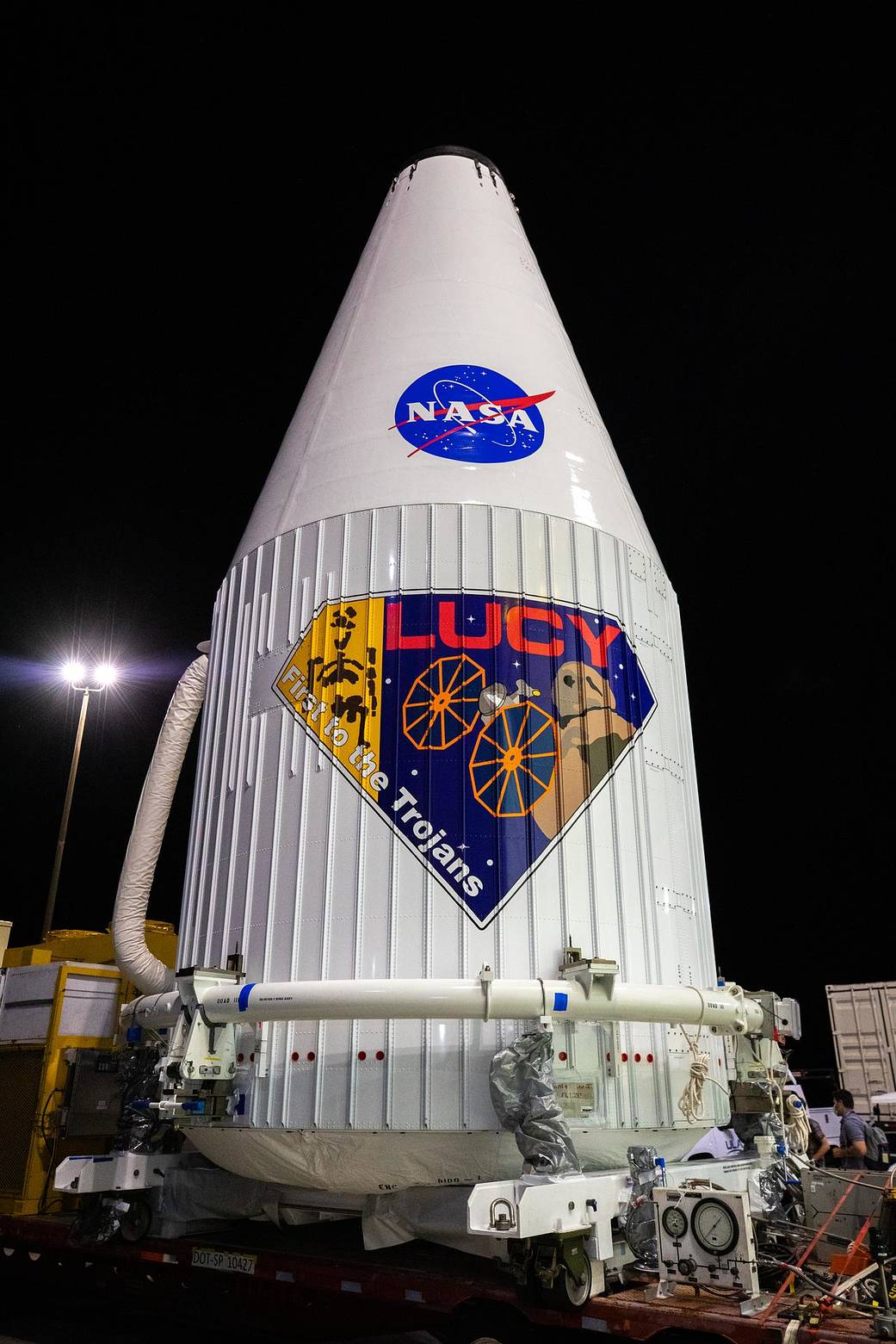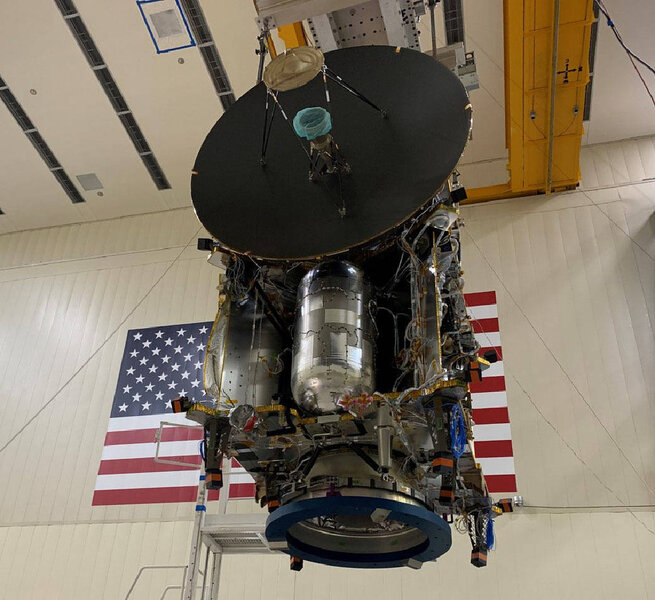Create a free profile to get unlimited access to exclusive videos, sweepstakes, and more!
Lucy's New Horizons DNA levels up to next-gen tech for asteroid closeups
When NASA’s Lucy mission does arrive at the Trojan asteroids in 2027, how will it see them?

NASA’s Lucy mission is now en route to the Trojan asteroids (SYFY WIRE was there to see the unreal takeoff). The journey will take a while, but when it does arrive at the Trojans in 2027, how will it see them?
Lucy has inherited upgraded versions of two its three main instruments from NASA’s New Horizons mission, which got up close and personal with Pluto and is still traversing the outer solar system looking for weird trans-Neptunian objects like Arrokoth. It also has genes from the OSIRIS-REx mission, which stopped by the asteroid Bennu and grabbed samples it's now headed back to Earth with. Other instruments on board Lucy are its High Gain Antenna for beaming data back to Earth and T2 Cam to capture ultra hi-res images.
Lucy Deputy Principal Investigator Cathy Olkin is co-principal investigator for New Horizons’ Ralph instrument, which merges a color camera with a near-infrared imaging spectrometer. She and her team have learned invaluable lessons that have carried over to Lucy’s versions of the New Horizons instruments. The expectations for L’Ralph and L’LORRI are astronomical.
“We’re using heritage versions of LORRI and Ralph instruments that explored Pluto and Arrakoth,” she told SYFY WIRE. ”We wanted to capitalize on that experience base and heritage on Lucy, so we took those instruments and improved them for the Trojan asteroids.”
The original Ralph and LORRI are still alive. LORRI (Long Range Reconnaissance Imager) imaged Jupiter and its moons before flying out to Pluto and imaging the demoted former planet and its satellites. When New Horizons encountered a space rock that kind of resembled BB-8, it imaged an object that shocked the world, made Twitter explode, and is now known as Arrokoth. It also figured out the albedos of Pluto and Charon. Objects with a low albedo will absorb light while those with a high albedo will bounce most of that light back into space.
L’LORRI is not the only camera Lucy is equipped with, but the most sensitive. It is actually the same type of panchromatic (can pick up on light wavelengths across the spectrum) camera Hubble uses. When light hits L’LORRI, it will be reflected by the primary mirror after it makes its way down the tube. This is a hyperbolic mirror, which can focus light from one focal point to the other with the most precision and accuracy possible. The reflected light will be re-reflected and focused by a secondary mirror before passing through an opening in the primary and ending up at a pair of lenses.
“For L’LORRI, we added redundant electronics to make it more robust,” Olkin said. “On New Horizons, that wasn’t required in the payload, but it is on Lucy, so we wanted to make sure it was robust by adding those electronics.”
Less is known about the Trojans than was known about Pluto before New Horizons launched, but no one even knew Arrokoth existed, so there was that. Anything that can level up the quality of the images taken by New Horizons’ LORRI instrument will be that much more of an asset to Lucy. The Trojans are faint and barely visible to Hubble. Lucy needs to find out as much as it can about them on each flyby, and redundant electronics, which are clones of each other within the same spacecraft, will give it serious backup — but it can’t do this alone.
The amazing thing about L’LORRI is that it does’nt even bother with a focusing system or any moving parts at all. It could risk damage during such a treacherous trip through space, so its optical system is built of silicon carbide that can hold up through extreme temperatures and drastic temperature shifts. Though L’LORRI will help Lucy navigate, and its superhero vision could see the Washington Monument from Chicago, it has a narrow field of view. Lucy’s T2 cam has a wider FOV that will lend it more accuracy when observing the Trojans.
L’LORRI will image each asteroid multiple times and process them so background stars won’t interfere. To transmit images that will wow the entire planet once again, it also needs to work together with L’Ralph.
“On L’Ralph, we extended the wavelength range to go out further,” said Olkin. “We also added an additional color channel and changed which wavelengths’ color channels correspond to match material phylocsilicate hydrated minerals on the Trojans so our color channels will help us map phylosilicates across the surface.”
Phylosilicates are minerals such as mica, talc, and clay, which can give away the chemical weathering that might have happened on the Trojans. This is especially important when it comes to the potential differences between gray C-types like Eurybates and red D-types like Orus. Though everything is speculative for now, one possibility is that the reddish hue of D-type asteroids may only be the result of reactions on the surface. Their insides could be gray. If that ends up being true, it could mean that both groups came from the same kind of parent bodies, though this will remain unknown until Lucy gets a closer look.
L’Ralph is two instruments in one. MVIC (Multispectral Visible Imaging Camera) is its color visible imager and LEISA (Linear Etalon Imaging Spectral Array) is its infrared spectrometer.
LEISA will get infrared light zapped to it by the diamond beam splitter inside, so Lucy really is in the sky with diamonds. MVIC also has five color bands so it can see in any wavelength in the spectrum, and it is its red band which can detect phylosilicates. LEISA will be able to find out how substances on the surfaces of the Trojans absorb and emit light at various wavelengths, which will allow it to identify ices that are incapable of forming in the inner solar system.
“On New Horizons, Ralph can scan across targets,” Olkin said. “For L’Ralph, we added a scan mirror, so the additional mirror inside the instrument allows us to build up the image time delay integration camera. Targets will be scanned across a focal plane chart as [the] camera is shifted along different lines in the detector.”
The presence of certain ices could mean an asteroid formed much further out. This is in line with the thinking that many of the Trojans might be the same kind of debris found in the faraway, freezing Oort belt.
Also scanning in infrared, though in far as opposed to near-infrared, will be L’TES, which gets its DNA from OSIRIS-REx. The Trojans absorb and then emit solar far-infrared radiation. The telescope in L’TES can detect radiation on the far end of the infrared part of the spectrum. It might not be the instrument that images the Trojans like we’ve never seen them before, but though it was never meant to be an imager, the data it gathers can be put together with what L’Ralph’s LEISA instrument observes to give an idea of how the surfaces of these asteroids became what they are over billions of years. Olkin looks forward to what that could reveal.
“L’TES was a build-and-print instrument very similar to TES on OSIRIS-REx,” she said. “Since L’TES will be able to get the temperatures of the asteroid surfaces, it will let us see the porosity of the surface.”
Maybe Ralph broke the internet in the movie, but when new images and discoveries come out of L’Ralph and its fellow instruments, that will break it for real.



























